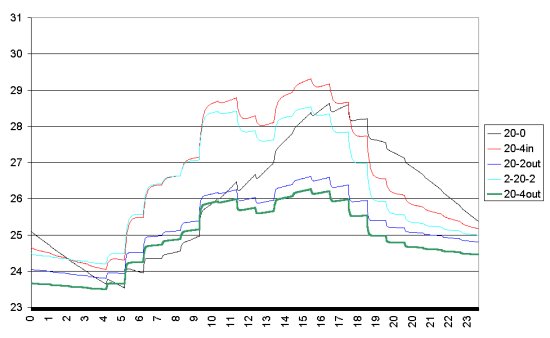Joseph Nowarski
-
Energy
Conservation
Expert
Influence of
TTC - Thermal Time Constant
on Temperatures and Energy Consumption in Buildings
based on BESO -
Building Energy Simulation and Optimization
to download Hebrew document Word 97 - click here
Abstract
Outside insulation contributes more than inside insulation to moderate
extreme temperatures in buildings in summer
and to lower energy consumption for heating
and air conditioning.
TTC static calculation not always reflexes these benefits.
To find the dynamic influence of the inside/outside insulation
of the outside wall and the roof,
BESO program is easily applied.
Following are results of the BESO calcutions
for 100 m2 floor area residential apartment in Jerusalem and Tel Aviv in middle floor,
for 20 cm concrete outside wall, in following cases:
20-0 = 20 cm concrete wall, no insulation
20-4in = 20 cm concrete wall, 4 cm polystyrene foam inside insulation
20-2out = 20 cm concrete wall, 2 cm polystyrene foam outside insulation
2-20-2 = 20 cm concrete wall, 2 cm polystyrene foam inside insulation and 2 cm polystyrene foam outside insulation
20-4out = 20 cm concrete wall, 4 cm polystyrene foam outside insulation

The results show energy consumption of 3,366 kWh/year for inside insulation
of residential apartment in Jerusalem, and 2,896 kWh/year for same thickness
outside insulation.
Outside insulation will cause
significant energy saving of 14% in Jerusalem and 26% in Tel Aviv.
The BESO program allows also calculating maximum and minimum
room air temperatures
with or without heating or air conditioning.
The following example shows the maximum room air temperatures, without
air conditioning in middle floor apartment in Jerusalem.
Maximum July room temperatures in Jerusalem

The graph shows that even 2 cm outside insulation gives much
better results than 4 cm inside insulation.
These considerations should be taken into account
when designing homes for poor population that will
not use air conditioning.
In such case 26.3C using outside insulation
is quite comfortable temperature,
while 29.3C with inside insulation result in difficult living conditions.
BESO -
Building Energy Simulation and Optimization
Joseph Nowarski
-
Energy
Conservation
Expert
e-mail: nowarski@yahoo.com
created: 23 October 2005
updated: 17 Dec 2006

